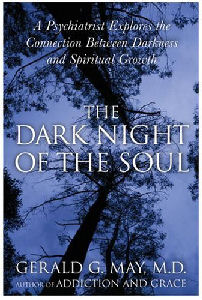
|
Posted May 1, 2005
A Psychiatrist Explores the Connection Between Darkness and Spiritual Growth Book: The Dark Night of the Soul Author: Gerald G. May, M.D. HarperSanFrancisco, pp.216 An Excerpt from the Introduction:
. . . Kushner says that God’s role in human suffering is to stand with us, giving us courage and strength and empowering us to respond with compassion and forgiveness. I agree. I also feel that the dark night of the soul reveals an even deeper divine activity: a continually gracious, loving, and fundamentally protective guidance through all human experience — the good as well as the bad. For Teresa of Avila and John of the Cross, the dark night — indeed all of life — is nothing other than the story of a love affair: a romance between God and the human soul that liberates us to love one another. If you are firmly convinced there is no God, this story will be a romantic fantasy, one that has generated some exquisite poetry. At the other extreme, if you are firmly convinced about who or what God is, you may have trouble with both the story and its poetry. For Teresa and John, the Beloved is endless Mystery, always beyond our capacity to comprehend. Therefore, if we have a choice, it is best for all of us to hold both our beliefs and disbeliefs lightly. Listen to the truth of your own life experience in the light of Teresa’s and John’s stories. That is where we begin. An Excerpt from the Book: The passive night of the spirit, as John sees it, is the process of emptying and freeing the spiritual faculties: intellect, memory, and will. It liberates them from attachment to rigidly held beliefs, understandings, dreams, expectations, and habitual, compulsive ways of loving and behaving righteously. . . . We become attached not only to our beliefs and concepts, but also to our dreams and expectations. An obvious modern example is when one partner in a relationship relentlessly expects the other partner to change abusive behavior. The attachment here is not to the abusive partner, but to an idealized image of what the changed person would be like. Such dreams die hard. And after they finally die, it may take a long time to appreciate the gift of freedom one has received. As another example, some people grow up believing that their faith and righteousness will bring them health, happiness, and even wealth. Sooner or later, life will likely teach them otherwise. At first they may ask the usual question: “Where did I go wrong?” Later the may be grateful for having developed a more realistic look — that the spiritual life is not, finally, a means to achieving one’s own superficial desires. Table of Contents: 1. Half a Friar The Story of Teresa and John 2. We are love The theology of Teresa and John 3. A deeper longing The liberation of desire 4. With a temple Meditation and contemplation 5. Three signs and three spirits The psychology of the night 6. The dark night today Modern contexts 7. Daybreak The coming of the dawn |
|
